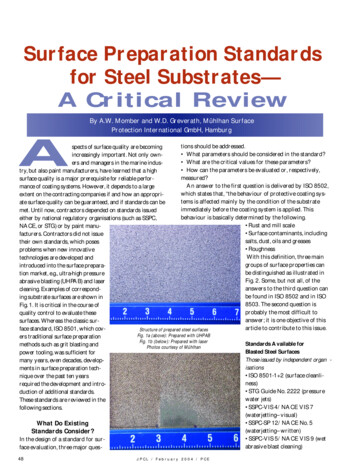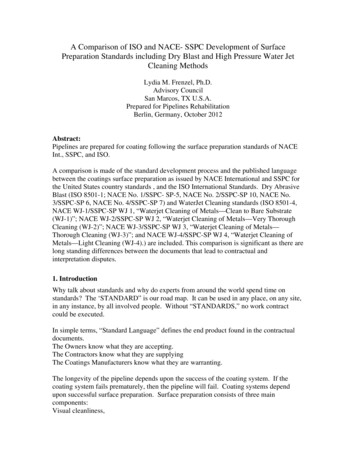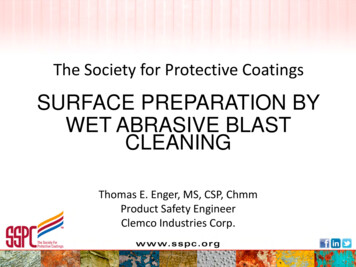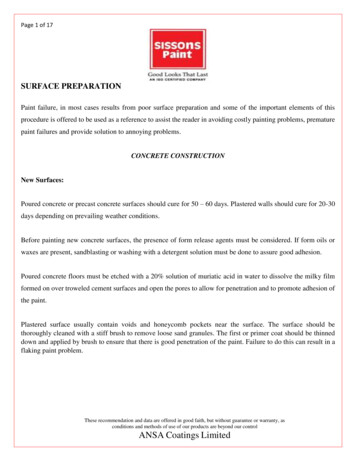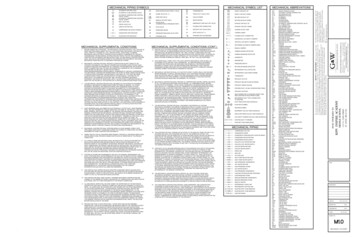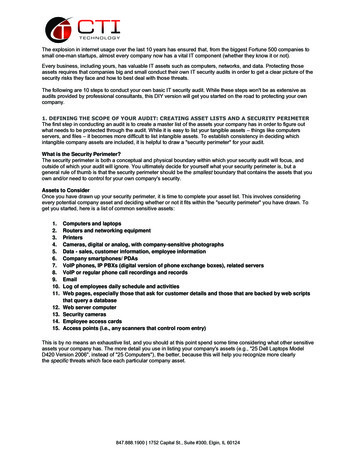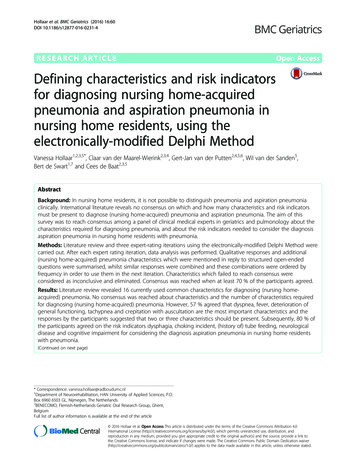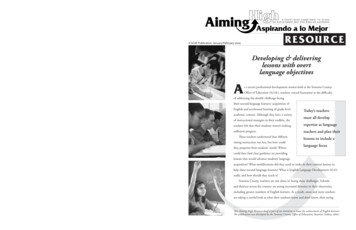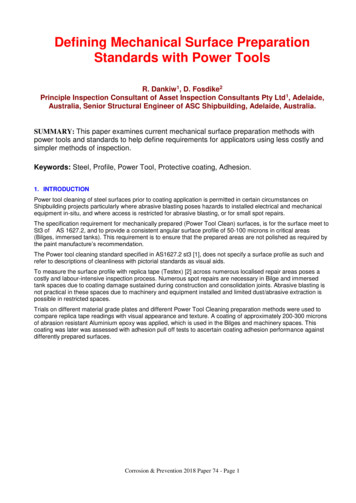
Transcription
PrintBack to List of PapersZoom InZoom OutPrevious PageNext PageCLOSE PAPERDefining Mechanical Surface PreparationStandards with Power ToolsR. Dankiw1, D. Fosdike2Principle Inspection Consultant of Asset Inspection Consultants Pty Ltd1, Adelaide,Australia, Senior Structural Engineer of ASC Shipbuilding, Adelaide, Australia.SUMMARY: This paper examines current mechanical surface preparation methods withpower tools and standards to help define requirements for applicators using less costly andsimpler methods of inspection.Keywords: Steel, Profile, Power Tool, Protective coating, Adhesion.1. INTRODUCTIONPower tool cleaning of steel surfaces prior to coating application is permitted in certain circumstances onShipbuilding projects particularly where abrasive blasting poses hazards to installed electrical and mechanicalequipment in-situ, and where access is restricted for abrasive blasting, or for small spot repairs.The specification requirement for mechanically prepared (Power Tool Clean) surfaces, is for the surface meet toSt3 of AS 1627.2, and to provide a consistent angular surface profile of 50-100 microns in critical areas(Bilges, immersed tanks). This requirement is to ensure that the prepared areas are not polished as required bythe paint manufacture’s recommendation.The Power tool cleaning standard specified in AS1627.2 st3 [1], does not specify a surface profile as such andrefer to descriptions of cleanliness with pictorial standards as visual aids.To measure the surface profile with replica tape (Testex) [2] across numerous localised repair areas poses acostly and labour-intensive inspection process. Numerous spot repairs are necessary in Bilge and immersedtank spaces due to coating damage sustained during construction and consolidation joints. Abrasive blasting isnot practical in these spaces due to machinery and equipment installed and limited dust/abrasive extraction ispossible in restricted spaces.Trials on different material grade plates and different Power Tool Cleaning preparation methods were used tocompare replica tape readings with visual appearance and texture. A coating of approximately 200-300 micronsof abrasion resistant Aluminium epoxy was applied, which is used in the Bilges and machinery spaces. Thiscoating was later was assessed with adhesion pull off tests to ascertain coating adhesion performance againstdifferently prepared surfaces.Corrosion & Prevention 2018 Paper 74 - Page 1
PrintBack to List of PapersZoom InZoom OutPrevious PageNext PageCLOSE PAPER2. EXPERIMENTAL DETAILS- SURFACE PREPARATION OF TEST PLATES2.1 Preparation of Test PlatesTest plates (approximately 200mm x 200mm x 5mm) were prepared from 3 different material grades used onthe project, as they have different hardness properties, which usually affects the degree of cleaning required: 250 Grade Carbon Steel250 MPa yield DH 36 Steel355 MPa yield DH 55 Steel550 MPa yieldThe initial condition of the plates was Grade A-B according to AS 1627 Part 4, and were prepared using rotatingmachine tools using 3 different abrasive discs, (see images 1-3), to achieve an approximate 50 micron surfaceprofile using replica tape: Grinder sanding disc- #36 Grit Flapper disc grinder #40 Grit Bristle Blaster DiscAll 3 different material grade plates were subjected to the 3 different abrasive discs, see example images (4-6)of DH 55 steel prepared (hardest steel), noting a grit blast comparator placed to obtain an idea of the texturalfeel by hand rather than a visual oneFigure 1- Grinder #36 sanding discFigure 4- DH55- #36 Die GrinderblasterTestex readings 30-40 micronsFigure 2- Flapper disc #40 GritFigure 5- DH55 – Flapper disc #40Testex readings 30-40 micronsCorrosion & Prevention 2018 Paper 74 - Page 2Figure 3- Bristle Blaster disc.Figure 6- DH55 material- BristleTestex readings 50-80 microns
PrintBack to List of PapersZoom InZoom OutPrevious PageNext PageCLOSE PAPERAfter the surfaces were prepared they were coated with 200-300 microns of the Aluminium Abrasive resistantepoxy coating. Three pull off testing dollies were glued to the cured coating (after one week), see figure 7.Figure 7- Pull off Dollies were glued several days before the 1.3.20183. RESULTS3.1 Adhesion Pull off Test ResultsAll 9 plates were subjected to pull off adhesive tests [1], with most failures occurring cohesively in the coating,with a small percentile with less than 20% of the dolly areas exhibiting adhesive failures to the preparedsurfaces, see example pull off test dollies on D55 material in figures 8, 9 & 10 for each preparation method.The adhesion values were well above the minimum 5 Mpa requirement for the coating using all preparationmethods. The Bristle blaster gave less variation of pull off Adhesion values than the other 2 methods, seegraphic figure 11. The bristle blaster gave a variation of approximately 2-3Mpa, whereas the # 36 grit grinder and#40 flapper disc grinder variations were greater (approximately 5Mpa).When comparing preparation methods and adhesion values across the 3 different material groups, the DH 36adhesion values appeared in the lower adhesion ranges, with the 250 and DH 55 grade material pull offadhesion values appearing in the higher ranges.The surface profile values of the Bristle blaster were consistently above 50 microns, whereas the other methodsmeasured profiles ranging from 30-40 microns, below the manufacturer’s recommendation.However, the lower measured profiles of the grinding discs were still able to produce compliant adhesion values.Figure 8- DH55 Pull off test on #36 grit grinder wheelCorrosion & Prevention 2018 Paper 74 - Page 3
PrintBack to List of PapersZoom InZoom OutPrevious PageNext PageFigure 9- DH 55 pull off test #40 flapper disc grinderFigure 10- DH55 - pull off test Bristle BlasterFigure 11- Adhesion values recorded against profile and method - all 3 material groups (250, DH 36, DH 55)Corrosion & Prevention 2018 Paper 74 - Page 4CLOSE PAPER
PrintBack to List of PapersZoom InZoom OutPrevious PageNext PageCLOSE PAPER4. DISCUSSION4.1 Power Tool Cleaning StandardsThe power tool cleaning standards specified by the paint manufacturer list the following as acceptable for spot orlocalised repairs: Pt 3 (JSRA SPSS:1984)- [4] SSPC-SP11- [5]However, some shipbuilding Coating specifications lists the applicable standard for power tool cleaning asAS1627.2 st3 (ISO 8501-1), which is not consistent with the coating manufacturer’s recommendations.When comparing the 3 standards below, only the SSPC-SP11 specifies a minimum surface profile value of 1 mill(25 microns). Table 1 gives a pictorial representation and description of the 3 standards used for power toolcleaning.The visual appearances in Table 1 across the ISO 8501-1, SSPC-SP11 and JSRA SPSS mechanicalpreparation standards are significantly different, particularly ISO 8501-1, where the description for st3preparation compared to the image is inconsistent with ‘very thorough cleaning producing a metallic sheen’.SSPC-SP11 section 3.4 provides more definitive surface preparation methods for producing a surface profileand refers to the use of replica tape to measure surface profile as detailed in section A.6. The visual standard(VIS-3) images are consistent with the descriptions, with the quality of the preparation photographs being verygood.The JSRA SPSS also provides good quality photographs that are consistent with the surface preparationdescriptions, however with no mention of surface profile values.In comparing the surface preparation methods used in the trial, the Bristle blaster disc gave the better surfaceprofile and a more consistent surface texture than the rotary flapper and sanding discs. The Bristle blaster ismore suited to preparing welds and edges due to the wire prongs being more flexible to follow shapes andcontours.The rotary and sanding discs gave a lesser profile compared to the bristle blaster but visually appeared brighterand shinier, indicating a more polishing effect.The Pull-off adhesion test results do not show a clear correlation between the adhesion pull off values across the3 preparation methods against profile height (microns) as shown in figure 11, other than the range (spread) ofadhesive values was narrower for the Bristle Blaster compared to the grinding discs.The adhesion values across the 3 different material grades were not showing distinctive groupings other thanDH36 material showing the lowest band of adhesion values across all preparation methods. No clear explanationcould be deduced on the why the 250 grade and DH55 materials were producing higher adhesion values thanDH36, considering that the 250 grade material is a softer hardness grade, compared to the DH55 being thehardest grade.The Bristle Blaster surface appearance closely resembles the grit comparator and measured surface profilevalues on the test plates.Corrosion & Prevention 2018 Paper 74 - Page 5
PrintBack to List of PapersZoom InZoom OutPrevious PageNext PageTable 1- Comparison of Power Tool Cleaning StandardsPower toolCleaningStandardDefinition/DescriptionAS 1627.2 st3Very thorough handand power toolcleaning when viewedwithout magnification,the surfaces shall befree from visible oil,grease and dirt andfrom poorly adheringmill scale, rust, paintcoatings and foreignmatter. But thesurface shall betreated much morethoroughly to give ametallic sheen arisingfrom the alFinishingPreparationand pretreatment ofsurfaces Part2: Power toolcleaningSSPCSP11(VIS 3)The Societyfor o. 11- PowerTool cleaningto Bare Metal.Pt 3 tionStandard forthepreparation ofsteel surfaceprior topaintingMetallic surfacesWhen viewed withoutmagnification shall befree from all visible oil,grease, dirt, dust, millscale, rust, paint,oxide, corrosionproducts, and otherforeign matter. Slightresidues of rust andpaint may be left in thelower portion of pits ifthe original surface ispitted.Pictorial- for Grade B steelRemarksThe pictorial standardimage does not match thedescription. Hand andpower tool cleaningmethods are not separated.Power tool methods aredescribed that include;rotary wire brushes, needleguns, abrasive grinders,flap wheels etc.Courtesy ISO-8501-1The standard states that ifthe surface is to be painted,it shall be roughened to adegree suitable for the paintsystem. The surface profileshall not be less than 1 mil(25 microns).Courtesy SSPC-SP11-VIS 3Surface from whichrust and other foreignmatter are removed bythorough preparationof disc-sander to theextent that the surfacehas a uniform metallicsheen.Preparation Methods arelisted and include; needlegun, rotary impact flapassemblies,coatedabrasive discs.JB- is to denote the steelsurface has been exposedto weather forapproximately 1.5 months.The surface is covered withred rust, but there remainsmill scale without pittingunderneath the red rust.Preparation Methods arelisted and include discsanding and rotary wirebrushing.Courtesy JSRACorrosion & Prevention 2018 Paper 74 - Page 6CLOSE PAPER
PrintBack to List of PapersZoom InZoom OutPrevious PageNext PageCLOSE PAPER5. CONCLUSIONSBristle blasting was able to produce a consistent profile meeting the shipbuilding coating specification on baresteel and more consistent coating adhesion properties across a variety of material grades, and is more suitablefor welds and contours.The comparison of the SSPC, AS/ISO and JSRA pictorial standards are widely different than the appearancesshown in the trials. The SSPC- SP11 standard and corresponding SSPC-VIS 3 pictorial images provide agreater ability for visual assessment of prepared surfaces due to better representational images and moredetailed information contained in the pictorial standards.Shipbuilding coating specifications need to be written to be consistent with the coating manufacturer’srecommendations to ensure consistency and clarity on acceptance criteria of surface preparations. The ISO8501-1 pictorial standard is not considered appropriate to use in lieu of SSPC-SP11 or JSRA SPPS due to thepictorial quality of the st3 power tool cleaning not consistent with its description of ‘very thorough cleaningproducing a metallic sheen’.The Bristle blast texture closely resembles the grit comparator and can be used in lieu of using replica tape forsurface preparation profile assessment for localised or spot repairs on bare steel.6. ACKNOWLEDGMENTSMany thanks to Daniel Fosdike. Daniel is the Senior Engineer in coatings and materials for ASC Shipbuildingwho greatly assisting in the collection and collation of technical data for this paper.7. REFERENCES[1] AS1627.2- Metal Finishing- Preparation and pre-treatment of surfaces Part 2: Power tool cleaning.[2] AS3894.5- Site Testing of protective coatings, Method 5: Determination of surface profile.[3] ISO 4624- Paints and varnishes- Pull-off test for adhesion.[4] Japanese Shipbuilding Research Association (JSRA)-Standard for the Preparation of Steel Surface prior toPainting[5] The Society for Protective Coatings (SSPC)-Surface Preparation Specification no. 11- Power Tool cleaning toBare Metal.Corrosion & Prevention 2018 Paper 74 - Page 7
PrintBack to List of PapersZoom InZoom OutPrevious PageNext Page8. AUTHOR DETAILSThe author has had over 35 years’ inspection experience in theconstruction and maintenance of; ships, submarines, oil and gasfacilities, pipelines and civil structures.Roman is the Principal Inspection Consultant of his company AssetInspection Consultants, that provides inspection services to industryRoman holds inspection certifications in coatings (NACE level 3),welding (WTIA, IIW), pressure equipment (AICIP) and Fireproofing &Insulation (Icorr level 2). Roman is the Chair of the recently reformedACA Defence Technical Group and is a past ACA National President(2010).Daniel Fosdike is the Senior Engineer for materials and coatings atASC Ship building. In this r
SSPC-SP11(VIS 3) The Society for Protective Coatings Surface Preparation Specification no. 11- residues of rust and Power Tool cleaning to Bare Metal. lower portion of pits if Metallic surfaces When viewed without magnification shall be free from all visible oil, grease, dirt, dust, mill scale, rust, paint, oxide, corrosion products, and other foreign matter. Slight paint may be left in the .
